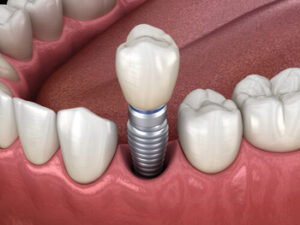Navigating the world of dental care can sometimes feel overwhelming, especially when you’re considering significant procedures like dental implants. If you’ve been pondering the cost of dental implants in Australia, you’re not alone.
Dental implants have become an increasingly sought-after solution for replacing missing teeth, offering a permanent and natural-looking alternative to traditional dental bridges or poorly fitting dentures. Let’s dive deep into understanding the intricacies of this dental treatment and the factors affecting its cost.
What Are Dental Implants?
Dental implants are replacement tooth roots, typically made of a titanium implant material, that provide a strong base for fixed or removable replacement teeth. Unlike alternative tooth replacement options, dental implants fuse with the jaw bone, offering stability, preventing bone loss, and preserving facial structure.
Factors Impacting the Cost of Dental Implants in Australia
Various elements influence the cost of dental implants in Australia:
- Type and Number of Implants: A single tooth implant will naturally cost less than full-mouth dental implants. Furthermore, choosing between single dental implants, multiple tooth implants, or implant-supported dentures can also alter the price.
- Location of the Missing Tooth: Replacing teeth in certain areas, especially where there are more complicated dental problems, might be costlier due to the intricacy involved in dental implant placement.
 Dental Procedure Complexity: Some patients require additional treatments like bone grafting, sinus lift, or bone augmentation to strengthen the jaw bone before the dental implant procedure can proceed.
Dental Procedure Complexity: Some patients require additional treatments like bone grafting, sinus lift, or bone augmentation to strengthen the jaw bone before the dental implant procedure can proceed.- Choice of Dental Implant Material: While titanium is the commonly used material, ceramic dental implants, being a premium option, might have a different price point.
- Dental Practice: Cost of dental care varies depending on the practice. With their high overheads, metropolitan areas may have slightly steeper rates than regional ones.
- Dental Insurance: While many private health insurance companies cover major dental treatments, the amount they cover for dental implants varies. Some might include the basic tooth extraction, while others might extend their dental health insurance benefits to cover a portion of the dental implant cost.
A Breakdown of Dental Implant Costs
- Single Tooth Implant: The price of a straightforward tooth implant placement for a single missing tooth might start from $3,000. This estimate includes the dental implant surgery, the implant itself, and the crown (replacement tooth).
- Multiple Dental Implants: For those needing several teeth replaced, multiple dental implants generally start from $6,000.
- Full Mouth Dental Implants: The most comprehensive solution, full mouth dental implants, can replace all teeth in the upper and lower jaw. The cost of this extensive procedure, which can include implant-supported bridge cost considerations, on average, starts from $15,000.
- Additional Procedures: The cost of a bone graft might start from $500. Similarly, the cost of a sinus lift can start from $2,000.
While these figures provide a general guideline, it’s essential to remember that the cost of dental procedures varies. The National Dental Fee Survey can also be a helpful resource in understanding average prices, though getting a direct quote from a dental practice is always recommended.
Advantages of Dental Implants Over Other Dental Treatments
Dental implants have become a go-to choice for those needing to replace missing or damaged teeth. The reasons for their prominence go beyond just aesthetics, even if the initial costs seem high compared to other dental treatments.
- Natural Look and Feel: Dental implants stand out because of their ability to replicate the form and function of natural teeth. Unlike cosmetic dentistry procedures like dentures or bridges, dental implants offer:
- Seamless Integration: They fuse with the jawbone, providing a stable foundation that doesn’t shift or move. This stability is key in allowing individuals to chew, speak, and interact with confidence.
- Aesthetic Excellence: Dental implants eliminate gaps caused by missing teeth, offering a complete and vibrant smile. The replacement teeth used with implants are custom-designed to match the surrounding teeth shape and shade, ensuring they don’t stand out.
- Durability: Dental implants aren’t just a short-term solution. With diligent oral care:
- Lasting Impact: Dental implants, particularly the titanium implant, which acts as an artificial tooth root, can serve patients for decades, if not a lifetime.
- Cost-Effectiveness: When viewed over their lifespan, the cost of dental implants becomes more justifiable. Traditional dentures or bridges, which might need replacement every 5-15 years, can lead to higher cumulative costs over time.
- Preservation of Oral Health: The strategic design of dental implants offers considerable benefits:
- Minimal Impact: Dental bridges, for instance, require adjacent teeth to be filed down to support them. Dental implants avoid such alterations, preserving the integrity of surrounding teeth.
- Prevention of Dental Issues: Without gaps between teeth, there’s less room for food particles to get trapped, reducing risks of gum disease and tooth decay.
- Jawbone Protection: Missing teeth aren’t just a cosmetic concern:
- Bone Loss Prevention: The jawbone requires constant stimulation, typically provided by natural teeth, to maintain its density. Dental implants offer this stimulation, preventing the jawbone from deteriorating over time.
- Facial Structure Maintenance: Bone loss in the jaw can lead to facial sagging. By preventing this, dental implants maintain the natural shape of one’s face.
Is the Dental Implant Procedure Painful?
Pain and discomfort are valid concerns when considering dental procedures. Here’s a detailed look at the experience:
- During the Procedure: Dental implant procedures in Australia are conducted under local anaesthesia. This ensures the treatment area is numb, allowing patients to undergo the dental implant placement without experiencing discomfort.
- Post-Operative Sensations: It’s natural to feel some tenderness and swelling in the days following the procedure. These sensations are a part of the healing process. Most individuals find relief with over-the-counter pain relief medications and following aftercare recommendations provided by their dentist.
 How to Navigate Dental Implant Costs
How to Navigate Dental Implant Costs
- Research and Compare: Look Beyond the Price Tag: While cost is an essential factor, the experience and expertise of the dental practice, the quality of dental implant material used, and the level of post-operative support and care are crucial determinants of the treatment’s overall value.
- Gather Multiple Quotes: Dental implants vary depending on various factors. It’s advisable to obtain multiple quotes to ensure you’re getting a fair price.
Dental Insurance:
- Coverage Variance: Dental insurance plans can differ significantly. While some might offer generous coverage towards dental implants, others might cover just the associated dental treatments like tooth extraction or dental procedures leading up to the implant placement.
- Know Before You Go: Before committing to dental implants, review your dental insurance policy or speak with your provider to understand what’s covered and what’s not.
Payment Plans:
- Flexible Financing: Recognising the high cost of dental procedures, many practices now offer payment plans. These plans can significantly ease the immediate financial burden, allowing patients to pay in instalments.
Preventive Care:
- Oral Hygiene: Regular brushing, using fluoride toothpaste, and flossing can prevent many dental issues.
- Regular Check-Ups: Dentists can spot potential problems early, often when they are more manageable and less costly to treat.
- Lifestyle Choices: Reducing sugar intake, avoiding tobacco and limiting alcohol can contribute to better oral health, reducing the likelihood of needing dental implants in the first place.
Understanding the Dental Implant Process in Depth
Dental implant surgery is a multi-step process, each designed to ensure that patients receive a strong, durable replacement for their missing or damaged teeth. But what does the journey to a new smile entail? Let’s delve into the intricacies of the dental implant process in Australia.
Initial Consultation:
Before diving into the dental implant procedure, an initial consultation is necessary. During this session:
- Diagnosis and Assessment: The dentist conducts a comprehensive oral examination, utilising X-rays and sometimes 3D imaging to get a detailed view of your mouth, jawbone, and teeth.
- Treatment Discussion: The patient’s oral health, the number of missing teeth, and jaw bone quality are considered before formulating a dental treatment plan. This discussion also allows patients to understand the dental implant costs associated with their specific case.
Bone Grafting and Sinus Lift (If Necessary):
Not every patient requires these procedures, but they’re crucial for those with insufficient jaw bone density or volume:
- Bone Grafting: A bone graft might be necessary if the jaw bone is too thin or soft to support an implant. This process involves adding bone or bone-substitute material to the area, allowing for more secure implant placement.
- Sinus Lift: For implants in the upper jaw, if there’s not enough bone height or if the sinuses are too close to the jaw, a sinus lift may be recommended. It involves adding bone below the sinus.
Dental Implant Placement:
This phase marks the core of the dental implant procedure:
- Implant Insertion: The dentist creates a small incision in the gum, exposing the bone. Holes are then drilled into the bone so the dental implant (which will act as the tooth root) can be placed.
- Healing and Osseointegration: Once the implant is placed, a significant healing phase begins, called osseointegration. This is when the jaw bone grows around the dental implant, securing it in position. This process can take several months but is crucial for a stable foundation.
Abutment Placement:
Once osseointegration is complete, the dental implant procedure progresses to the next stage:
- Abutment Insertion: An abutment is a small connector post that holds the new tooth. To place the abutment, the dentist reopens the gum to expose the dental implant so they can attach it and then allows the gum tissue to heal around it.
- Tooth Impressions: Once the gums heal, impressions of the mouth and remaining teeth are taken. These impressions are used to make the crown, which will be the visible part of the dental implant.
Crown Attachment:
The final stage in the dental implant journey involves placing the crown:
- Selecting the Type of Crown: Depending on the patient’s preference and the dentist’s recommendation, a crown is chosen.
- Attaching the Crown: The crown, custom-made to fit and match the patient’s natural teeth is then attached to the abutment.
Factors Influencing Dental Implant Costs in Australia
While we have touched upon the dental implant process, it’s essential to understand the myriad factors that influence dental implant costs:
- Geographical Location: Just as with other services, where you get your dental implants in Australia can influence the price. Larger metropolitan areas might have higher costs compared to smaller towns.
- Dental Implant Material: The choice of material for dental implants can significantly impact costs. Titanium is a commonly used material known for its durability and biocompatibility. However, ceramic dental implants, favoured for their aesthetic appeal, might come at a different price point.
- Number and Type of Implants: A single-tooth implant cost differs from full-mouth dental implant costs. Similarly, the price can vary between implant-supported dentures and implant-supported bridge costs.
- Supplementary Procedures: As mentioned earlier, some patients require bone grafting, sinus lifts, or tooth extractions before the dental implant procedure. These additional procedures add to the overall dental treatment costs.
- Laboratory Costs: The creation of custom crowns, bridges, or dentures entails laboratory costs. The choice of materials and craftsmanship can influence these costs.
- Dental Health Insurance Benefits: Dental health insurance benefits vary between providers. While some may cover major dental treatments, others might focus on preventive care. The extent of dental insurance coverage will affect patients’ out-of-pocket dental implant costs.
- Dental Practice Overheads: Dental care varies depending on the dental practice’s overheads. A practice with state-of-the-art equipment, plush interiors, and situated in a high-rent district might have higher costs than a more modest setup.
Long-Term Care for Dental Implants
While dental implants mimic natural teeth in many ways, they require dedicated care:
-
 Daily Oral Hygiene: Just as with natural teeth, dental implants should be brushed and flossed daily. Special brushes, such as interdental brushes, can help clean hard-to-reach areas around the implant.
Daily Oral Hygiene: Just as with natural teeth, dental implants should be brushed and flossed daily. Special brushes, such as interdental brushes, can help clean hard-to-reach areas around the implant. - Regular Dental Check-Ups: Periodic visits to the dentist ensure that the dental implants and surrounding gums remain in good health.
- Avoiding Hard Foods: Chewing hard items, like ice or hard candy, can damage the crowns. It’s best to avoid or limit such foods.
- No Smoking: Tobacco can weaken the bone structure and might lead to implant failure. If you’re considering dental implants, it’s an excellent reason to quit smoking.
- Watch for Grinding: Teeth grinding can place undue stress on dental implants. If you’re prone to grinding or clenching your teeth, discuss this with your dentist. They might recommend a night guard to protect your implants and natural teeth.
By understanding the dental implant process and its associated costs, potential patients can make informed decisions about their oral health. Dental implants in Australia are a testament to advanced dental technology, offering a promising solution for those looking to restore their smiles. With the right care, these implants can be a lasting testament to a renewed commitment to oral health.
In Conclusion
Dental implants represent one of the pinnacle achievements in modern dentistry. They offer a robust, long-lasting solution for those with missing or damaged teeth, promising both functionality and aesthetics. While the cost of dental implants in Australia can seem daunting initially, many find the expense justifiable when viewed as a long-term investment in one’s health, confidence, and well-being.
If you’re considering dental implants or have further questions about any aspect of the procedure and its costs, don’t hesitate to reach out. Contact Oakleigh Smiles at (03) 9007 2258 to set an appointment. Our team has the expertise and tools needed to help you achieve the perfect smile.
Note: Any surgical or invasive procedure carries risks. Before proceeding, you should seek a second opinion from an appropriately qualified health practitioner.
References:
http://pmiaustraliaconference.org.au/the-complete-guide-to-dental-implants-cost-in-australia/






